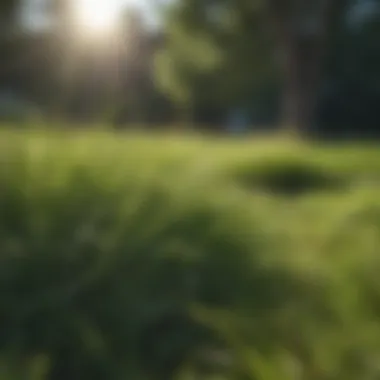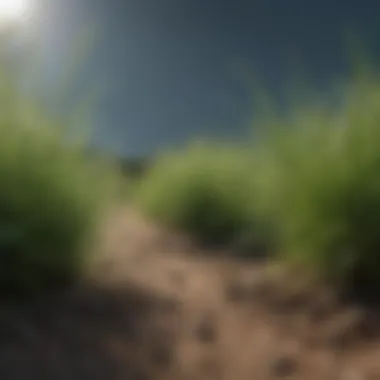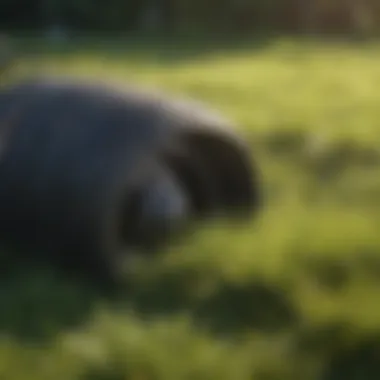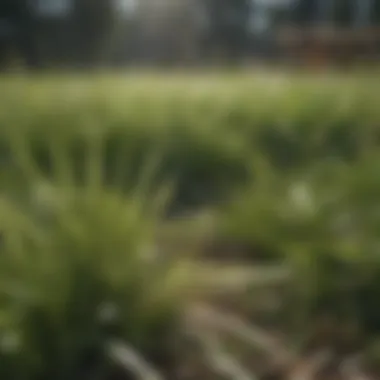Understanding Factors That Kill Poa Grass


Intro
Poa grass, often recognized for its broad blades and bright color, can symbolize an aesthetic lawn. However, keeping it healthy and vibrant is no small feat. Several factors contribute to its decline, pushing both amateur lawn enthusiasts and professional horticulturists to find effective solutions. This article explores those factors in detail, offering insights into the nuances of maintaining Poa grass.
Understanding its vulnerabilities in relation to environmental conditions, biological threats, and management practices is essential. The following sections will elucidate key concepts and terminology, current trends, innovations, and practical applications to enhance lawn care strategies.
Key Concepts and Terminology
Definition of Terms
Before diving into the intricacies of Poa grass management, it is important to clarify certain terms that will frequently appear in this discussion.
- Poa grass: A common genus of grass, often found in cooler climates; it includes species such as Poa pratensis (Kentucky bluegrass).
- Environmental stress: Factors such as drought, excessive moisture, or temperature fluctuations that adversely affect grass growth.
- Biological threats: Includes pests, fungi, and diseases that can impede the health of Poa grass.
- Management practices: Techniques utilized to cultivate and maintain healthy grass, including mowing, watering, and fertilization.
Overview of Relevant Practices
Managing Poa grass effectively requires a mix of approaches tailored to its specific needs. Key practices include:
- Regular mowing to promote even growth.
- Appropriate watering schedules that prevent drought stress and over-saturation.
- Applying suitable fertilizers based on soil tests to ensure nutrient availability.
Understanding these terms and practices provides a foundation for readers as they navigate solutions for maintaining robust Poa grass.
Current Trends and Innovations
Latest Research and Developments
In recent years, research has unveiled improved techniques for managing Poa grass. For instance, studies emphasize the importance of soil health, advocating for practices like cover cropping and organic amendments. These practices enhance soil structure and nutrient content, resulting in healthier grass.
Researchers have also examined the impact of climate change on Poa grass, highlighting the need for increased adaptability in management strategies.
Emerging Technologies and Tools
With advancements in technology, lawn care has benefited from new tools designed to improve the precision of management practices. Innovations such as soil moisture sensors and drone technology offer data-driven insights into lawn health. This allows users to optimize watering schedules and assess overall grass health more effectively.
Investing in these technologies can lead to sustainable practices, resulting in a healthier lawn ecosystem.
Practical Applications
Step-by-Step Guides
To apply the information discussed, the following guide offers actionable steps to maintain your Poa grass effectively:
- Conduct a soil test to determine nutrient levels and pH balance.
- Develop a watering schedule based on environmental conditions, ensuring the grass receives an adequate amount of water without waterlogging the roots.
- Mow regularly, keeping the cutting height appropriate to encourage healthy growth.
- Fertilize according to soil test results, considering slow-release options to support long-term nutrient needs.
- Monitor for pests and diseases, applying preventative measures as necessary.
Troubleshooting Common Issues
Common challenges with Poa grass include discoloration and patchiness. To troubleshoot these issues:
- Check for proper watering practices, as both under and over-watering can cause problems.
- Ensure that proper nutrient levels are maintained through testing and fertilization.
- Investigate any signs of pest damage or disease, and address them promptly to prevent further decline.
Understanding and applying these practices can significantly enhance the longevity and appearance of Poa grass in any lawn or landscape.
"Successful management of Poa grass is not just about individual practices but understanding the interactions between environmental conditions, biological threats, and appropriate care strategies."
Optimizing your approach takes time and knowledge, but the rewards are evident in a thriving lawn. The following sections of this article will continue to explore the various aspects that impact Poa grass health, offering readers useful insights.
Preface to Poa Grass Ecology
Understanding the ecology of Poa grass is essential for anyone involved in landscaping or horticulture. Poa grass is a widely recognized species, prevalent in various regions, yet it faces many challenges that can affect its health and growth. This section aims to explore the unique characteristics and common varieties of Poa grass. By grasping these foundational elements, readers can better assess the strengths and weaknesses of this grass in their landscapes.


Characteristics of Poa Grass
Poa grass, specifically Poa pratensis, commonly known as Kentucky bluegrass, is a cool-season grass with several distinctive features. Its blade is narrow and smooth, typically ranging from a light to a rich green color. The leaves tend to be quite fine, which can provide a lush appearance when well-maintained. One notable characteristic is its growth habit, where Poa grass spreads through underground rhizomes. This allows it to fill in bare spots over time but also makes it susceptible to competition from other aggressive plant species.
Moreover, Poa grass has a highly adaptive nature, thriving in various soil types. However, it prefers well-aerated and nutrient-rich soils. Its ability to recover quickly after damage is a valuable trait, particularly in areas that experience heavy foot traffic. Nonetheless, this resilience is often tested under environmental stress. Understanding its characteristics helps in devising effective management strategies that address the common pitfalls for maintaining robust Poa grass.
Common Varieties
There are several varieties of Poa grass, each suited to different climates and environmental conditions. Two of the most widely recognized include Poa pratensis and Poa annua, known as annual bluegrass.
- Poa pratensis is characterized by its dense growth, making it a favorite for lawns and sports fields. Its tolerance to drought and cold make it popular in northern regions. However, it can struggle in shady areas unless properly managed.
- Poa annua, on the other hand, is known for its short life cycle and ability to germinate under a variety of conditions. While it can fill in spaces quickly, it often becomes a nuisance due to its tendency to go to seed rapidly, contributing to an uneven lawn appearance.
Identifying the specific variety present in a given location is crucial. This understanding allows for targeted management practices tailored to the grass’s needs and vulnerabilities. Integrating knowledge about the characteristics and varieties of Poa grass sets the stage for a deeper exploration of the many factors that affect its health and longevity.
Impact of Environmental Conditions
The health of Poa grass is significantly influenced by various environmental conditions. These factors are crucial in determining the viability and resilience of this grass species, particularly in challenging climates. Understanding these conditions helps in implementing effective management strategies. The key environmental factors include soil quality, moisture levels, temperature fluctuations, and sunlight exposure. Each of these elements interplays with the others, creating a complex ecosystem that impacts Poa grass health.
Soil Quality and Nutrients
Soil serves as the foundation for Poa grass survival. The composition of the soil can drastically affect nutrient availability. Well-drained loamy soil is generally preferred. Nutrients like nitrogen, phosphorus, and potassium are essential for growth. Insufficient nutrients can lead to yellowing, stunted growth, or even death of the grass. It is effective to conduct soil testing periodically and amend the soil based on the results. Organic materials like compost can enhance nutrient content and improve soil structure. Understanding the nutrient profile is key to maintaining lush, healthy lawns.
Moisture Levels and Irrigation
Water plays a pivotal role in Poa grass maintenance. Consistent moisture is crucial; however, the balance is delicate. Overwatering can suffocate roots, causing rot, while lack of water leads to drought stress. Different growth stages of Poa grass have varied water needs. It’s useful to monitor soil moisture levels with a moisture meter or by hand testing. Furthermore, proper irrigation techniques should be employed. Techniques such as deep watering encourage root growth, making the grass more resilient.
Temperature Fluctuations
Poa grass is sensitive to temperature changes. Optimal growth occurs in moderate conditions, typically between 60°F and 75°F (16°C to 24°C). Sudden drops or spikes can stress the plant. For instance, extreme heat can lead to browning, while unexpected frost can cause damage to tender shoots. Understanding the local climate can assist in planning planting times effectively. Implementing practices like shade provision during extreme heat can also help mitigate temperature-related stress.
Sunlight and Shade Conditions
Sunlight is necessary for photosynthesis. While Poa grass can tolerate some shade, too much can inhibit growth. Ideal conditions require at least 4 to 6 hours of direct sunlight daily. Conversely, excessive sunlight can lead to dry patches and vulnerability to pests. Assessing the location where Poa grass is planted is important. For areas with mixed sunlight and shade, selecting shade-tolerant grass varieties may provide a solution. Adjusting surrounding landscapes to optimize light exposure can improve the overall health of Poa grass.
Biological Threats to Poa Grass
Understanding biological threats to Poa grass is crucial for anyone involved in maintaining lawns or landscapes. These threats can significantly affect the health and growth of this common grass species. When we look into these biological factors, we can identify and manage issues effectively. Each threat, be it a disease, pest, or competition from other plants, can severely weaken Poa grass, leading to bare patches and overall decline.
Disease Pathogens
Pathogens are one of the most serious threats to Poa grass. Different fungi, bacteria, and viruses can affect the grass, leading to various symptoms. Some common diseases include snow mold, dollar spot, and brown patch. Each of these diseases presents unique challenges for grass health.
Snow mold is particularly problematic in cooler climates. It thrives under snow cover, leading to unsightly mats of dead grass. Dollar spot, on the other hand, appears during warm weather and manifests as small, round patches. Managing these diseases often requires the application of fungicides and adopting proper cultural practices, such as maintaining good air circulation and adequate watering to discourage disease development.
Important considerations for disease management include:
- Regularly inspecting grass for early signs of disease.
- Understanding the specific conditions that favor each pathogen.
- Implementing timely rotations of fungicides to avoid resistance.
Pest Infestations
Insects also pose a significant risk to Poa grass. Various pests, from grubs to chinch bugs, can damage the root systems or foliage of the grass. For instance, chinch bugs feed on the grass blades, causing yellowing and eventually death. Grubs can damage the roots, making it easier for diseases to take hold.
Effective pest control starts with proper identification of the pest involved. Knowledge of their lifecycle and feeding habits can lead to better management strategies. For example, certain beneficial insects can be introduced to the environment to keep pest populations in check.
Key strategies for managing pests include:
- Monitoring for signs of infestation.
- Applying insecticides when necessary, focusing on targeted approaches.
- Maintaining healthy grass to increase resilience against pest attacks.
Competition from Weeds


Weeds represent a formidable challenge to Poa grass survival. They compete for sunlight, nutrients, and water, often outpacing Poa grass in growth. Common weeds, such as crabgrass and dandelions, can quickly establish in a lawn, leading to a decline in the overall aesthetic and health of the grass.
Managing weed competition requires a multifaceted approach. Regular mowing can prevent weeds from seeding. Additionally, employing pre-emergent herbicides can help control weed growth before they start. Moreover, ensuring the grass is thick and robust can naturally suppress weed establishment.
Strategies to combat weed competition include:
- Implementing a solid mowing schedule.
- Utilizing appropriate herbicide treatments.
- Encouraging a dense carpet of Poa grass to inhibit weed growth.
Effective management of biological threats not only enhances the aesthetics of lawns but also supports a healthy ecosystem where Poa grass can thrive.
Being aware of these biological threats helps maintain the health and longevity of Poa grass in various landscapes. Knowledge is essential for successful management that ultimately leads to thriving green spaces.
Chemical Treatments and Their Risks
The use of chemical treatments, specifically herbicides and fertilizers, plays a significant role in managing the health of Poa grass. Understanding how these chemicals affect the growth and sustainability of Poa grass is crucial for anyone involved in horticulture and landscaping. The decision to apply chemical treatments should not be taken lightly, as the benefits are accompanied by specific risks that can influence both the grass and the surrounding environment.
Herbicides and Their Effectiveness
Herbicides are often used to control unwanted weeds in lawns, which can compete with Poa grass for nutrients and water. The effectiveness of these herbicides varies. Some are selective, targeting only specific types of weeds, while others are non-selective, killing any plant they come in contact with. When selecting a herbicide for Poa grass, it is important to consider the weed species present in the lawn.
- Selective herbicides generally allow Poa grass to remain unharmed while eliminating the competition.
- Non-selective herbicides can destroy Poa grass, making them a poor choice for this type of grass.
Applying herbicides at the right time and in the right conditions is vital. Poor timing, such as applying during hot weather or drought, can result in ineffective treatments or even damage to Poa grass.
Impact of Fertilizers
Fertilizers provide essential nutrients that support plant growth. However, using fertilizers incorrectly can negatively impact Poa grass. Over-fertilization can lead to excessive growth, making the grass vulnerable to diseases and pests.
There are two main types of fertilizers:
- Granular fertilizers offer a slow release of nutrients, which helps sustain long-term growth.
- Liquid fertilizers can deliver nutrients quickly but must be applied carefully to avoid burning the grass.
It is essential to use soil tests to determine the specific nutrient needs of Poa grass before applying any fertilizers.
Additionally, using fertilizers right before a rainstorm can lead to runoff, which pollutes waterways and disrupts local ecosystems.
In summary, applying chemical treatments like herbicides and fertilizers can offer benefits to Poa grass management, but understanding their risks is crucial for effective lawn care.
Cultural Practices for Management
Cultural practices play a crucial role in the health and viability of Poa grass. These practices encompass a variety of management strategies that can either support or hinder the growth of this grass species. It is essential to understand that optimal care begins with recognizing how certain actions affect the overall well-being of Poa grass.
Implementing effective cultural practices can lead to healthier lawns and landscapes. This section covers the significance of mowing techniques, aeration and soil compaction, and the choice between overseeding and replacement. Each can profoundly impact the maintenance and longevity of Poa grass in different environments.
Mowing Techniques
Mowing is not simply a chore; it is a vital component of Poa grass care. The height and frequency of mowing influence the grass's ability to photosynthesize and establish itself. Mowing too short can stress the grass, exposing it to more potential threats, such as pests or diseases.
Recommended practices include:
- Mowing height: Maintain a height of around two to three inches for Poa grass. This range encourages deep root development and better moisture retention.
- Frequency: Mow regularly during the growing season, ensuring that no more than one-third of the leaf blade is removed at any one time.
Prioritizing these techniques can foster a stronger Poa grass lawn and minimize its susceptibility to external threats.
Aeration and Soil Compaction
Soil compaction is detrimental to Poa grass as it restricts root development and water infiltration. Aeration, a process that involves perforating the soil to allow air, water, and nutrients to reach the roots, is essential in preventing this compaction.
Here are key points to consider:


- Conduct aeration at least once a year, ideally in the fall or spring. This timing aligns with the grass's growing cycles.
- Soil testing: Before aerating, assessing soil conditions can provide insight into how compacted it is and whether additional measures, such as adding organic matter, are needed.
By utilizing aeration effectively, the soil structure can improve, leading to better water and nutrient availability for Poa grass.
Overseeding vs. Replacement
Choosing between overseeding and complete replacement is an integral decision for maintaining Poa grass areas. Overseeding introduces new seeds into an existing lawn, helping to rejuvenate it without the need for total eradication. This method can be less disruptive and less expensive.
In contrast, complete replacement may be considered when:
- The grass is significantly damaged, with large areas of bare soil.
- There are invasive species outcompeting the Poa grass.
When overseeding, ensure:
- Use high-quality seeds suited for the local environment.
- Prior to overseeding, mow the grass lower and rake to enhance seed-to-soil contact.
Making an informed decision about overseeding versus replacement can preserve the integrity of Poa grass, ensuring its longevity in diverse landscapes.
Conducting proper cultural practices not only enhances the resilience of Poa grass but also promotes a sustainable environment in which it thrives.
Understanding these cultural practices is foundational for any gardener or landscaper looking to effectively manage Poa grass. By addressing mowing, aeration, and seeding choices thoughtfully, one can significantly enhance the health and aesthetics of Poa grass lawns.
Innovative Solutions and Technologies
Innovative solutions and technologies are becoming increasingly crucial in managing Poa grass health. The complexity involved in maintaining this grass species calls for advanced strategies, especially as traditional methods may not be sufficient alone. By integrating new technologies and research advancements, stakeholders can enhance their approach to preventing decline and promoting longevity of Poa grass.
The benefits of adopting these solutions include improved efficiency in resource usage, enhanced disease management and proactive approaches to pest control. Additionally, these strategies can significantly bolster the resilience of Poa grass in varying environmental conditions. Stakeholders in horticulture and landscaping often focus on these innovations to remain competitive and effective in their practices.
Genetic Advancements in Grass Breeding
Genetic advancements have long been a focus in agriculture. In the context of Poa grass, selective breeding can lead to improved strains that are more resistant to diseases and pests. Such developments can produce grass varieties that require less maintenance and withstand harsher environmental conditions. These genetic improvements reduce the risk of total grass loss due to the factors that commonly afflict Poa grass.
Research institutions and universities often collaborate with seed companies to create these superior varieties. This progress is shaping the future of how Poa grass can be cultivated, making it more sustainable and robust in landscaped areas.
Utilizing Technology for Monitoring
The role of technology in monitoring grass health cannot be understated. Tools such as soil moisture sensors and drone technology provide crucial information about the condition of Poa grass and its growth environment. By deploying these technologies, farmers and landscape professionals can gather real-time data, which allows for timely interventions.
Regular monitoring using smartphone applications can track moisture levels, pest outbreaks, or nutrient imbalances. This capability enables more informed decision making. For instance, when soil moisture is detected to be low, irrigation can be applied efficiently, saving water and improving grass health.
"Embracing technology in grass management is essential for optimizing results and fostering sustainable practices."
Epilogue of Innovations
Innovative solutions and technologies represent the next frontier in Poa grass management. By harnessing genetic advancements and employing modern monitoring tools, stakeholders can pave the way for healthier grass that withstands various challenges. These methods not only improve the viability of Poa grass but also contribute to a more sustainable approach to landscaping and agriculture.
Finale and Future Directions
The exploration of factors that impact Poa grass health reveals several layers of complexity. Understanding these components is essential for the effective management and care of this common grass species. As we have discussed, environmental influences, biological threats, and cultural practices all play critical roles in determining the vitality of Poa grass. Acknowledging these influences allows landscape professionals and enthusiasts alike to make informed decisions that will ultimately enhance the resilience of Poa grass in various settings.
Key elements to consider when managing Poa grass include:
- Environmental conditions: Regular assessments of soil, moisture, and light levels can provide insights for optimal growth.
- Biological threats: Awareness of pathogens and pests enables preemptive actions to mitigate damage, ensuring sustainable health.
- Cultural practices: Adapting mowing techniques and aerating the soil can recover or improve grass health over time.
The benefits of understanding the factors that harm Poa grass extend beyond aesthetics. Healthier Poa grass contributes to soil stability and pest attraction. This insight is particularly valuable not only for maintaining attractive landscapes but also for fostering biodiversity and ecological balance in residential or commercial areas. Moreover, as climate patterns shift and new threats emerge, staying informed about these dynamics can enhance resiliency in grass management practices.
Summary of Key Findings
A summary of key findings in our examination reveals crucial insights into Poa grass management. These findings can guide future efforts in maintaining healthy lawns and landscapes. The highlights are:
- Environmental Conditions: Soil quality and moisture retention are vital for Poa grass. Nutrient-rich soils with adequate water promote growth while preventing stress from drought or compaction.
- Biological Threats: Diseases and pest infestations, such as dollar spot and armyworms, can severely impact Poa grass health. Effective monitoring and early intervention strategies are essential to prevent outbreaks.
- Management Practices: Techniques such as proper mowing and aeration can significantly improve Poa grass vigor. Understanding the right balance of overseeding and replacing damaged patches is also critical for long-term health.
Taking a holistic view of management practices will help mitigate challenges posed to Poa grass, ensuring successful growth and landscape beauty over time.
This comprehensive approach sets the foundation for innovative future solutions, potentially incorporating cutting-edge technology and research to further enhance management practices. Continued attention to the evolving landscape of Poa grass care will be crucial for all stakeholders invested in its health.







